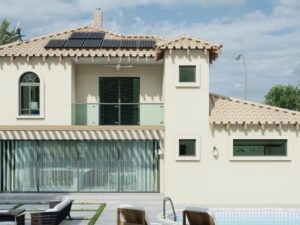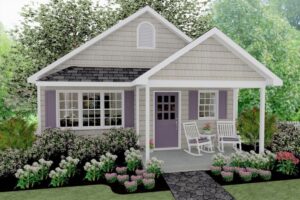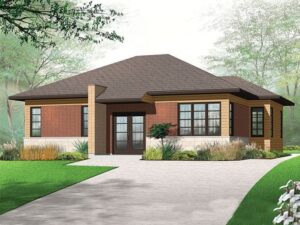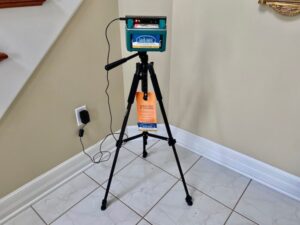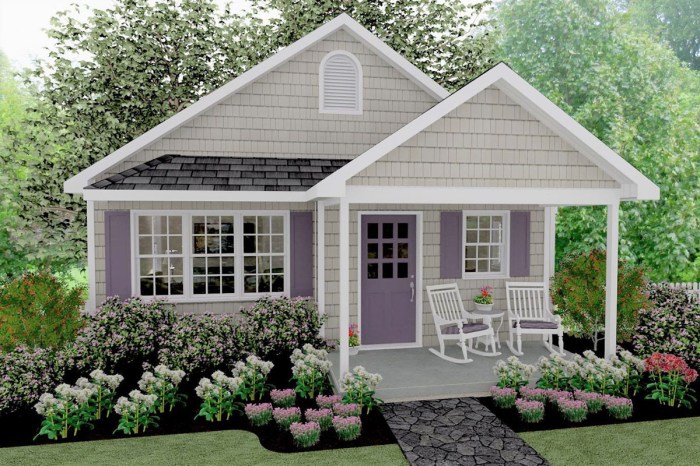
Tiny house floor plans are revolutionizing the way we think about living spaces. With increasing interest in minimalist lifestyles, these compact designs promise efficient use of space without sacrificing comfort or style. Whether you’re dreaming of a mobile tiny home or a stationary one nestled in the woods, there’s a world of creative layouts waiting to be explored.
This article delves into the essential aspects of tiny house floor plans, from various styles and designs to innovative storage solutions and sustainable practices. We will guide you through what makes tiny living appealing, ensuring you have all the information to make informed decisions when it comes to your dream tiny home.
Tiny House Floor Plans Overview

Tiny house living is a lifestyle choice that emphasizes simplicity, sustainability, and minimalism. With rising housing costs and a growing awareness of environmental issues, more individuals and families are embracing the tiny house movement as a viable alternative to traditional living spaces. The appeal lies not only in the affordability but also in the opportunity to downsize possessions and live a more intentional life.
Tiny house floor plans serve as the backbone of this movement, showcasing various designs tailored to meet the needs and preferences of tiny house dwellers. These plans are crafted to maximize space and functionality, often featuring innovative storage solutions and multi-purpose furniture. A fundamental aspect of tiny house design is the efficient use of limited square footage, ensuring every inch is utilized in a way that enhances comfort and livability.
Fundamental Features of Tiny House Floor Plans
The essential features of tiny house floor plans can significantly influence the overall functionality and aesthetic appeal of the living space. Understanding these features allows potential owners to select a design that best suits their lifestyle. Key characteristics include:
- Open Layouts: Many tiny homes feature open floor plans that create a sense of space and flow, reducing the feeling of confinement.
- Lofted Sleeping Areas: Utilizing vertical space, lofts are common in tiny houses, providing cozy sleeping quarters while freeing up the main floor for daily activities.
- Compact Kitchens: Tiny homes often incorporate modern, compact kitchens equipped with essential appliances, maximizing cooking efficiency without sacrificing style.
- Flexible Furniture: Multi-functional furniture, such as foldable tables and convertible sofas, is crucial for maximizing the usability of the living area.
Common Dimensions and Layouts for Tiny Homes
Tiny homes typically adhere to specific dimensions and layouts that cater to their compact nature. These standards not only help in planning but also ensure compliance with zoning laws and regulations in various regions. The most common dimensions for tiny houses include:
- Width: Most tiny homes range from 8 to 12 feet wide, with 8 feet being the standard for trailers used for mobility.
- Length: The length can vary from 16 to 30 feet, depending on the desired space and configuration.
- Total Square Footage: Tiny homes generally fall between 100 to 400 square feet, allowing for a range of layouts while maintaining a compact form.
Layouts can vary widely, but frequently include:
- Single-Story Designs: These homes emphasize accessibility and ease of movement, suitable for those preferring no stairs.
- Two-Story Designs: Utilizing vertical space effectively, these homes often feature lofts for sleeping and additional storage areas.
- Split-Level Designs: Some designs incorporate different levels to delineate spaces, adding visual interest and a more spacious feel.
“The beauty of a tiny house lies in its ability to transform minimalism into a delightful living experience.”
This thoughtfully designed approach to tiny house living not only maximizes space but also enhances the overall quality of life for those who choose this unique lifestyle.
Types of Tiny House Floor Plans
Tiny houses have gained popularity for their efficient use of space and ability to promote a minimalist lifestyle. When selecting a tiny house floor plan, it’s essential to understand the various styles available, as each offers unique features and benefits. This section provides an overview of different types of tiny house floor plans, highlighting their characteristics and layout options.
Styles of Tiny House Floor Plans
Choosing the right style for your tiny house floor plan can significantly impact your living experience. Below are some popular styles, along with their pros and cons, to help you make an informed decision:
- Modern
A modern tiny house often features clean lines, large windows, and open spaces.
Pros: Emphasizes simplicity and functionality, often includes energy-efficient features, and is visually appealing with a sleek design.
Cons: Can be more expensive due to high-quality materials and contemporary finishes, may prioritize aesthetics over practical storage solutions.
- Rustic
Rustic tiny houses evoke a cozy, warm atmosphere with natural materials and traditional design elements.
Pros: Offers a charming, homey feel, often includes wood finishes and handcrafted elements, and connects with nature.
Cons: May require more maintenance, can feel less spacious if not well-designed, and often lacks modern conveniences.
- Minimalist
A minimalist design focuses on reducing clutter and maximizing functional space.
Pros: Encourages a decluttered lifestyle, efficient use of space leads to lower costs, and often features multi-functional furniture.
Cons: May feel too sparse for some, lacks decorative elements that create a personalized touch, and can be challenging to design for practicality.
Layout Variations
The layout of a tiny house plays a crucial role in maximizing its functionality and livability. Two common layout variations are open floor plans and segmented spaces. Each layout has distinct advantages and considerations.
- Open Floor Plans
Open floor plans create a seamless flow between living spaces, often combining the kitchen, dining, and living areas into one.
Pros: Enhances the perception of space, allows for better natural light distribution, and fosters social interaction.
Cons: Can lead to noise issues, may lack privacy in multi-use areas, and requires careful design to ensure functional zoning.
- Segmented Spaces
Segmented spaces define different areas within the tiny house, using walls or partial dividers for separation.
Pros: Provides privacy and distinct purpose for each area, can enhance organization, and allows for more tailored design solutions.
Cons: May feel cramped if not designed thoughtfully, can limit natural light flow, and may not maximize the use of vertical space.
Designing Tiny House Floor Plans
Designing a tiny house floor plan requires a thoughtful approach to maximize every inch of space while ensuring comfort and functionality. With the right strategies, you can create an efficient living environment that feels spacious and welcoming. This guide touches on essential guidelines for layout, innovative storage solutions, and multifunctional furniture options that make tiny living not only possible but also enjoyable.
Maximizing Space in Tiny House Designs
Creating an efficient layout is key to maximizing space in a tiny house. Employing a few strategic design concepts can significantly enhance your living area. Here are some guidelines to consider:
- Open Floor Plan: Keeping walls to a minimum creates a sense of spaciousness. An open floor plan blends living, dining, and kitchen areas seamlessly.
- Vertical Space Utilization: Take advantage of high ceilings by installing shelves and cabinetry that reach up to the ceiling. This draws the eye upward and creates a more open feeling.
- Multi-Zone Areas: Design spaces that can serve multiple purposes. For instance, a dining area can double as a workspace with the right furniture arrangement.
- Natural Light: Incorporate large windows or skylights to let in natural light, making the space feel larger and more inviting.
- Sliding Doors: Replace traditional doors with sliding doors to save space and add a modern touch.
Creative Storage Solutions
In a tiny house, clever storage solutions are vital for maintaining organization and functionality. Here are some inventive ideas that can be integrated into your floor plan:
- Under-Bed Storage: Utilize the space under your bed for storage by incorporating drawers or bins, which can hold everything from clothes to seasonal items.
- Built-In Furniture: Consider furniture with built-in storage, such as benches with compartments or ottomans that open up to store belongings.
- Wall-Mounted Racks: Install wall-mounted racks for items such as bikes, shoes, or kitchen utensils, freeing up valuable floor space.
- Foldable Furniture: Use foldable tables and chairs that can be easily tucked away when not in use, creating more open space.
- Nook Storage: Make use of nooks and crannies in your home by adding shelves or cabinets in these often-overlooked areas.
Multifunctional Furniture Options
Multifunctional furniture is a game changer in tiny home design, allowing you to maximize utility while minimizing clutter. Here are some effective options to incorporate:
- Sofa Beds: A sofa bed provides a comfortable seating option by day and a cozy sleeping arrangement by night, perfect for accommodating guests.
- Extendable Dining Tables: Tables that can expand or contract based on your needs are ideal for hosting family dinners or saving space when not in use.
- Murphy Beds: Folding beds that can be stored vertically against the wall offer a practical solution for using space flexibly.
- Storage Ottomans: Ottomans that double as storage units allow for seating, footrests, and hidden compartments for blankets or magazines.
- Convertible Desks: A desk that can transform into a dining table or work surface helps maintain functionality without taking up unnecessary space.
Thoughtful design and innovative solutions can transform a tiny space into a comfortable and efficient home.
Home Furniture for Tiny Houses
Furnishing a tiny house presents unique challenges and opportunities, as the limited space requires a careful selection of home furniture. Essential pieces not only need to be functional but also space-efficient, allowing for a comfortable living environment without feeling cramped. This section highlights key furniture considerations for tiny homes, including multifunctional designs and aesthetic choices that harmonize with a compact lifestyle.
Essential Furniture Pieces for Tiny Homes
Choosing the right furniture is crucial in maximizing the potential of a tiny house. Essential pieces should serve more than one purpose while being compact enough to fit into the available space. Here are some fundamental items to consider:
- Murphy Bed: This versatile bed folds up against the wall when not in use, freeing up floor space during the day.
- Expandable Dining Table: A table that can be extended when needed is ideal for hosting guests without sacrificing everyday space.
- Storage Ottomans: These dual-purpose items can serve as seating while also offering hidden storage for blankets or other items.
- Wall-Mounted Shelving: Utilizing vertical space helps keep the floor uncluttered and provides room for books or decorative items.
- Convertible Sofas: A sofa that can transform into a guest bed ensures comfort during the day and practicality at night.
Benefits of Choosing Multifunctional Furniture
Multifunctional furniture offers numerous advantages, particularly in a tiny house where space is limited. These pieces are designed to serve multiple purposes, reducing the need for additional furniture and promoting a more organized environment. Key benefits include:
- Maximized Space: By combining functions, these items minimize clutter and make the most of every square inch.
- Cost-Effective: Investing in fewer, multifunctional pieces can be more economical than purchasing multiple items that serve single purposes.
- Enhanced Flexibility: Multifunctional furniture allows residents to easily adapt their living space for different needs, such as entertaining guests or creating a cozy workspace.
- Streamlined Aesthetic: Fewer pieces contribute to a cleaner look, helping to maintain a sense of openness and tranquility within the home.
Tips for Selecting Furniture that Complements Tiny House Aesthetics
Choosing furniture that aligns with the aesthetic of a tiny house is essential for creating a cohesive and inviting atmosphere. Here are some tips to guide the selection process:
- Opt for Light Colors: Furniture in lighter shades can create an illusion of more space, making the area feel airy and bright.
- Choose Sleek Designs: Minimalistic and streamlined designs reduce visual clutter and help maintain a spacious feel.
- Incorporate Natural Materials: Using wood, bamboo, or other natural materials can add warmth and comfort while enhancing the overall aesthetic.
- Consider Scale: Select furniture that is proportionate to the space; oversized items can overwhelm a tiny house and lead to a cramped environment.
- Personalize with Accessories: Utilize textiles and decor to reflect your style without adding bulky items; pillows, throws, and artwork can transform the look while still maintaining functionality.
Green Living in Tiny Homes
Incorporating sustainable practices into tiny house living is fundamental for those who prioritize environmental responsibility. Tiny homes lend themselves to eco-friendly living due to their smaller footprint, making it easier to integrate green technologies and materials. Here’s a deeper look into how to enhance your tiny home with sustainability in mind.
Methods for Incorporating Sustainable Practices
Sustainable practices in tiny homes can take various forms. Some key methods include:
- Use of Recycled and Renewable Materials: Select materials like reclaimed wood, bamboo, or recycled metal to minimize environmental impact. These materials not only look great but also reduce waste and the carbon footprint associated with new materials.
- Rainwater Harvesting: Installing a rainwater collection system can significantly lower water consumption. This involves channeling rainwater from the roof into storage tanks for reuse in irrigation or non-potable applications.
- Composting Toilets: Composting toilets are water-free and transform human waste into compost, reducing water usage and providing a natural fertilizer for gardens.
Energy-Efficient Appliances and Their Impact on Floor Plan Design
Energy-efficient appliances are crucial for maximizing efficiency in a tiny home. These appliances often have a smaller footprint and are designed to use less energy without sacrificing performance. When designing your floor plan, consider the following aspects:
- Total Energy Consumption: Prioritize appliances with high energy ratings, which can significantly lower your electricity bills. For example, ENERGY STAR-rated refrigerators and dishwashers are great choices.
- Space Planning: The layout must accommodate these appliances while allowing easy access. Combining kitchen and living areas can create an open, functional space while incorporating necessary appliances seamlessly.
- Alternative Energy Sources: Integrating solar panels into the design not only promotes sustainability but also aligns with your energy-efficient appliances, making your home self-sufficient.
Importance of Natural Light and Ventilation
Natural light and ventilation are vital in green tiny home designs, enhancing comfort while reducing energy usage. Adequate daylight minimizes the need for artificial lighting, and good airflow improves indoor air quality. Consider these elements:
- Maximizing Window Placement: Strategically place windows to allow for optimal sunlight throughout the day. South-facing windows are particularly effective for passive solar heating.
- Skylights: Installing skylights can introduce light into spaces that might otherwise remain dark, such as bathrooms or hallways, reducing the need for artificial lighting during daytime.
- Cross Ventilation: Design for airflow by positioning windows across from each other to promote natural cooling. This reduces reliance on air conditioning, especially in warmer climates.
“Incorporating natural light and ventilation can lead to significant energy savings and a healthier living environment.”
Heating and Air Conditioning Solutions
Creating a comfortable living environment in a tiny house requires thoughtful consideration of heating and air conditioning solutions. Due to the limited space, it is essential to choose systems that are efficient and effective, providing optimal comfort without consuming excessive energy. This section explores various options for heating and cooling tiny homes, the critical role of insulation, and compares HVAC systems suitable for compact living spaces.
Options for Heating and Cooling Tiny Homes
Tiny houses offer unique challenges and opportunities when it comes to climate control. The following systems are popular choices for heating and cooling tiny homes, each with its advantages and considerations:
- Mini-Split Heat Pumps: These systems provide both heating and cooling and are energy-efficient. They consist of an indoor and outdoor unit, allowing for zoned temperature control.
- Portable Air Conditioners: Ideal for renters or those who want flexibility, portable AC units can be moved as needed and require no permanent installation.
- Radiant Floor Heating: This method uses electric or hydronic heating to warm up the floor surface, providing even heat distribution and comfort underfoot.
- Wood Stoves: A traditional option that not only heats but also adds aesthetic value. Wood stoves can be effective in off-grid situations, utilizing renewable resources.
- Window Air Conditioners: Simple and cost-effective for cooling, these units require minimal installation and can be easily removed when not in use.
The Importance of Insulation
Insulation plays a vital role in maintaining comfortable temperatures in tiny homes. Proper insulation minimizes heat loss during winter and keeps the home cool in summer, leading to increased energy efficiency.
“Effective insulation can reduce heating and cooling costs by 30% or more, significantly impacting the overall energy consumption of a tiny house.”
Different types of insulation materials can be used, including:
- Foam Board Insulation: Offers high thermal resistance and is suitable for walls and roofs.
- Spray Foam Insulation: Provides excellent air sealing properties, ideal for irregular spaces.
- Fiberglass Batts: A cost-effective and widely used option, especially for wall cavities.
- Reflective or Radiant Barrier Insulation: Helps reflect heat, useful in warmer climates to keep homes cooler.
Comparison of HVAC Systems for Small Spaces
Selecting the right HVAC system for a tiny home depends on factors such as climate, budget, and the specific needs of the occupants. Here’s a comparative look at popular HVAC systems suitable for small spaces:
| HVAC System | Heating/Cooling Type | Energy Efficiency | Cost |
|---|---|---|---|
| Mini-Split Heat Pump | Heating & Cooling | High | Moderate to High |
| Portable AC | Cooling | Moderate | Low to Moderate |
| Radiant Floor Heating | Heating | High | High |
| Wood Stove | Heating | Variable | Moderate |
| Window AC | Cooling | Variable | Low |
Home Inspections for Tiny Houses

Tiny houses have gained popularity for their efficiency and minimalist lifestyle, but inspecting these compact spaces requires special attention. Given their unique structures and design elements, a thorough inspection helps ensure safety, functionality, and overall satisfaction for homeowners.Inspecting tiny homes involves several considerations that differ from traditional homes. The limited space and innovative designs can create challenges, such as accessibility to certain areas, integration of systems, and the overall durability of materials used.
Home inspectors familiar with tiny houses are essential for identifying potential issues that could arise from their unique construction and layout.
Inspection Considerations for Tiny Homes
When conducting an inspection on a tiny house, homeowners should be aware of several unique aspects. Here is a checklist of key areas to focus on during the inspection process:
- Structure Integrity: Check for any signs of cracking, settling, or shifting in the foundation and walls.
- Roof Condition: Inspect for leaks, missing shingles, and proper drainage systems.
- Electrical Systems: Ensure all wiring meets local codes and is appropriately sized for the home’s power needs.
- Plumbing: Verify that pipes are insulated, especially in colder climates, and look for leaks or inadequate drainage.
- Ventilation: Assess whether the space has adequate airflow to prevent moisture buildup and ensure air quality.
- Insulation: Check the quality and type of insulation used, as it significantly affects energy efficiency.
- Safety Equipment: Ensure smoke detectors, carbon monoxide detectors, and fire extinguishers are installed and functional.
Each of these areas plays a critical role in the overall functionality and safety of the tiny home. Addressing potential issues in these areas before they escalate can save homeowners from costly repairs and improve the living experience.
Common Issues Found in Tiny House Floor Plans
Tiny house floor plans can present unique challenges that need to be addressed during an inspection. Some of the most common issues encountered include:
- Poor Space Utilization: Many tiny homes struggle with maximizing space efficiency. Solutions include custom furniture that doubles as storage, such as beds with drawers or foldable tables.
- Inadequate Natural Light: A lack of windows can make a tiny home feel cramped. Installing skylights or larger windows can enhance brightness and openness.
- Suboptimal Layouts: Some designs may lead to inefficient traffic flow. Consider reconfiguring furniture placement or utilizing sliding doors to improve accessibility.
- Insufficient Heating or Cooling: Tiny homes can have difficulty maintaining temperature. Installing energy-efficient heating and cooling systems can optimize comfort.
- Materials Durability: The use of lightweight materials may compromise durability. Selecting high-quality, weather-resistant materials can enhance longevity.
By being aware of these potential issues and addressing them proactively, homeowners can significantly improve the safety and functionality of their tiny living spaces. Regular inspections and maintenance play a vital role in ensuring that these homes remain comfortable and efficient.
House Plans and Tiny Homes
Selecting or customizing house plans for tiny living requires careful consideration of space efficiency, functionality, and personal style. Tiny homes are often less than 400 square feet, so every square inch counts. The right house plan can make a significant difference in comfort and livability, ensuring that the limited space is utilized effectively. When it comes to tiny homes, various factors must be addressed to ensure that they are not only functional but also compliant with local regulations and sustainable.
The customization of house plans should reflect the unique needs and lifestyle of the owner while adhering to building codes and zoning laws.
Tips for Selecting or Customizing House Plans
Choosing the right house plan is crucial for maximizing your tiny living experience. Here are some essential tips:
- Assess Your Needs: Determine how many occupants will live in the space and what essential features are necessary for daily living.
- Prioritize Layout: Consider an open floor plan to create the illusion of more space and enhance flow between areas.
- Incorporate Multi-Functional Furniture: Choose designs that serve multiple purposes, such as a sofa bed or a dining table that doubles as a workspace.
- Design for Storage: Utilize vertical space and built-in storage solutions to keep belongings organized without cluttering the living area.
- Think About Outdoor Space: Integrate a deck or patio area that extends your living space into the outdoors.
Legal Considerations Surrounding Tiny House Construction
Understanding the legal framework is vital when embarking on a tiny house project. Tiny homes may face different regulations compared to traditional homes, so awareness of zoning laws and building codes is essential. Key legal considerations include:
- Zoning Restrictions: Check local zoning ordinances to understand where tiny homes can be placed, including land size and usage restrictions.
- Building Codes: Ensure designs comply with local building codes, which can dictate structural integrity and safety standards.
- Permitting Process: Familiarize yourself with the necessary permits required for construction, which can vary by location.
- Utilities and Infrastructure: Investigate how local codes regulate connections to water, sewage, and electricity in tiny homes.
- Insurance Requirements: Research insurance options that accommodate tiny homes and ensure adequate coverage.
Resources for Finding Pre-Designed Tiny House Plans
Several resources are available for individuals looking to explore pre-designed tiny house plans. Utilizing these resources can simplify the process of finding a plan that aligns with your vision:
- Online Design Platforms: Websites like Tiny House Listings and Tiny House Talk provide a plethora of designs and floor plans to choose from.
- Books and Publications: Numerous books offer a collection of tiny house plans, often accompanied by construction tips and material lists.
- Custom Builders: Many builders specialize in tiny homes and may offer customizable plans tailored to client specifications.
- Architects Specializing in Tiny Homes: Engaging an architect experienced in tiny homes can lead to a highly personalized design process.
- Community Workshops: Participating in tiny house workshops often provides access to plans and advice from experienced builders.
Ending Remarks
In conclusion, tiny house floor plans offer a unique opportunity to embrace a simpler, more sustainable way of living. By understanding the different styles, designs, and essential features, you can create a space that meets your needs while remaining stylish and eco-friendly. Whether you’re just starting your tiny living journey or are ready to build, the possibilities are endless.
FAQ Summary
What are the typical dimensions of tiny houses?
Most tiny houses range from 100 to 400 square feet, with common widths being 8.5 feet for trailers and up to 12 feet for stationary homes.
Can tiny houses be moved?
Yes, many tiny houses are built on trailers, allowing them to be mobile. However, it’s essential to check local regulations about moving them.
What are the benefits of multifunctional furniture?
Multifunctional furniture maximizes space and enhances flexibility, allowing for various uses while keeping clutter to a minimum.
How can I ensure my tiny house is energy efficient?
Incorporate energy-efficient appliances, proper insulation, and maximize natural light to reduce energy consumption.
Are there any legal restrictions on building tiny homes?
Yes, regulations vary by location, so it’s crucial to check local zoning laws, building codes, and other legal requirements before constructing a tiny home.
